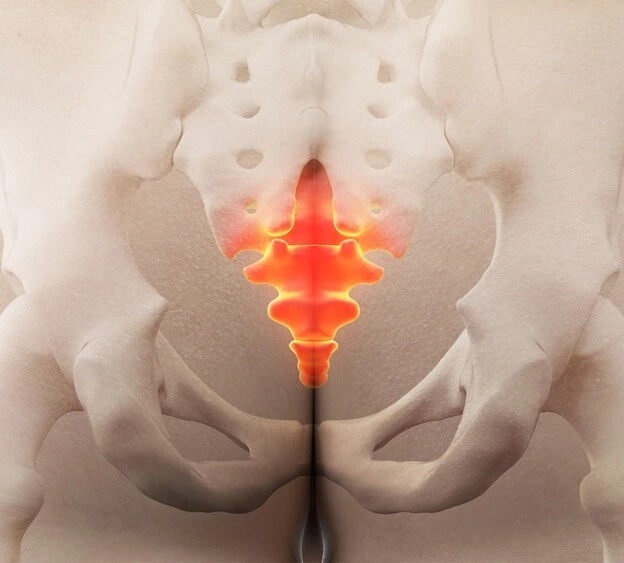Coccydynia is a medical condition that is characterized by pain in the coccyx or tailbone. The coccyx is a small bone located at the bottom of the spine, and is made up of several fused vertebrae. Coccydynia is a relatively common condition, affecting both men and women of all ages. In this article, we will explore what coccydynia is, some known causes of it, what symptoms and problems it can cause, usual treatment options, and why chiropractic care is an effective and affordable option for managing this condition.
What Is Coccydynia?
Coccydynia is a medical condition that is characterized by pain in the coccyx or tailbone. This pain can be acute or chronic and can be caused by a number of factors. The pain associated with coccydynia can be mild or severe and can interfere with a person’s ability to perform daily tasks, work, sit, relax and even sleep.

Examples of Causes of Coccydynia
There are a number of factors that can contribute to the development of coccydynia. One of the most common causes of coccydynia is trauma or injury to the coccyx. This can be caused by a fall, sports injury, or even childbirth. Other potential causes of coccydynia may include poor posture, prolonged sitting, and degenerative changes in the coccyx.
Symptoms and Problems Associated with Coccydynia
The symptoms of coccydynia can vary from person to person, but may include pain, tenderness, and discomfort in the area of the coccyx. This pain may be worsened by sitting or standing for long periods of time, and may be accompanied by numbness or tingling in the legs or buttocks. Coccydynia can also interfere with a person’s ability to perform daily tasks, work, and even sleep – tremendously interfering with their quality of life. Just sitting down to watch a movie with a loved one could be too much to take.
Usual Treatment Options
There are a number of treatment options available for managing coccydynia, including medication, physical therapy, and surgery. Medications such as non-steroidal anti-inflammatory drugs (NSAIDs) can be effective in reducing pain and inflammation. Physical therapy may involve exercises to strengthen the muscles of the lower back and hips, as well as stretches to improve flexibility. In more severe cases, surgery may be necessary to remove the coccyx. But, who would wan to do that?
Why Chiropractic Care Is an Effective and Affordable Option
Chiropractic care is a safe and effective option for managing or even curing coccydynia in most patients. Chiropractors use spinal adjustments and other manual therapies to help reduce pain and improve overall health. Studies have shown that chiropractic care can be effective in reducing pain and improving range of motion in patients with coccydynia.
One of the benefits of chiropractic care is that it has no to minimal side effects. Prescription medications for coccydynia can have a range of side effects, including drowsiness, dizziness, and nausea. In addition, these medications can be costly, especially if they need to be taken over a long period of time. Chiropractic care, on the other hand, is often covered by insurance and can be a cost-effective way to manage, or like mentioned earlier, even cure coccydynia.
In addition to pain relief, chiropractic care can also help improve overall health and well-being. Regular chiropractic adjustments can help improve joint mobility, reduce inflammation, and improve overall function. Chiropractors may also provide lifestyle advice such as exercise and nutrition to help patients maintain a healthy lifestyle.
Chiropractic Care Utilizing Zone Technique for Coccydynia
Any Zone Technique healer, including Dr. Post, knows exactly what to do for any condition walking into the office, including coccydynia. Since Zone Technique is able to unlock and unleash the powerful healing ability withing your body, your healing results will be significantly better than any other healing technique available today. Whether you have or someone else you know has coccydynia, balancing the body by utilizing Zone Technique will heal your body on a very deep level. Zone Technique healing is natural, effective, and permanent so that you will heal completely, function great and no longer have pain. You can be totally healthy again – feeling great and functioning perfectly from head to toe every day of the year!
If you don’t live close enough to see Dr. Post, search for a certified Zone Technique healer closer to you by searching the ZONE TECHNIQUE PRACTITIONER DIRECTORY. You owe it to yourself to take action so that you can heal and feel awesome again.
Conclusion
Coccydynia is a medical condition that can have a significant impact on a person’s daily life. While there are many treatment options available for managing coccydynia, chiropractic care is an effective and affordable option that can reduce pain, increase range of motion, and improve overall health. If you are suffering from coccydynia, consider exploring chiropractic care as a treatment option. A qualified chiropractor can work with you to develop a personalized treatment plan that addresses your specific needs and helps you manage your coccydynia effectively.

